
Eremophila delisseri is a flowering plant in the figwort family, Scrophulariaceae and is endemic to an area of the Nullarbor Plain in South Australia. it is a shrub with lilac-coloured flowers and with most of its parts covered with white hairs.
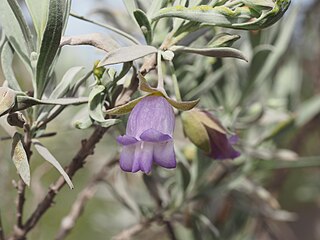
Eremophila maitlandii, commonly known as Shark Bay poverty bush, is a flowering plant in the figwort family, Scrophulariaceae and is endemic to Western Australia. It is a silvery-grey shrub with linear leaves and lilac-coloured to light purple flowers and is common in coastal areas between Shark Bay and Carnarvon.

Eremophila fraseri, commonly known as burra or jilarnu, is a flowering plant in the figwort family, Scrophulariaceae and is endemic to Western Australia. It is a shrub or small tree with all above-ground parts of the plant, apart from the petals, sticky and shiny due to the presence of a large amount of resin. The petals are coloured white, cream, pink and brown.

Eremophila mackinlayi, commonly known as desert pride, is a flowering plant in the figwort family, Scrophulariaceae and is endemic to Western Australia. It is a shrub with its branches and leaves covered with a thick layer of yellow to grey hairs, mostly egg-shaped leaves and deep lilac-coloured to purple flowers. It is most closely related to E. strongylophylla and E. hygrophana and sometimes occurs in the same areas as these species.

Eremophila strongylophylla is a flowering plant in the figwort family, Scrophulariaceae and is endemic to Western Australia. It is a small shrub with distinctive round leaves, yellowish new growth and purple flowers which are white inside. It is similar to Eremophila mackinlayi and Eremophila hygrophana but distinguished from them by characteristics including leaf shape, and the type of hairs on its leaves and branches.

Eremophila weldii is a flowering plant in the figwort family, Scrophulariaceae and is endemic to Australia. It is a shrub with glabrous green leaves, small sepals and purple or lilac-coloured petals and it occurs in arid and semi-arid areas of Western Australia and South Australia.

Eremophila hughesii is a flowering plant in the figwort family, Scrophulariaceae and is endemic to Australia. It is spindly, glabrous shrub with narrow leaves and with flowers that vary in colour from blue to pink, sometimes white. It is native to Western Australia and the Northern Territory.
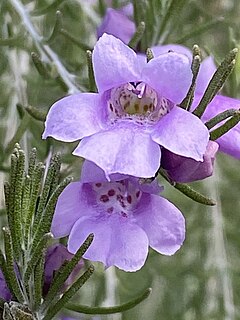
Eremophila microtheca, also known as heath-like eremophila, is a flowering plant in the figwort family, Scrophulariaceae and is endemic to Western Australia. It is an erect shrub with densely hairy branches and leaves, narrow leaves and pale lilac-coloured flowers and which emits a strong odour.
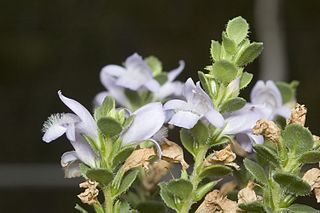
Eremophila behriana is a flowering plant in the figwort family, Scrophulariaceae and is endemic to South Australia. It was one of the plants collected on the 1858 - 1859 Babbage expedition to explore areas north of Adelaide and was later described by Ferdinand von Mueller. It is a small shrub, usually with egg-shaped, serrated leaves and lilac to purple flowers with hairs on the lower petal lobe.
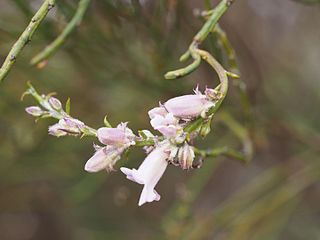
Eremophila dempsteri is a flowering plant in the figwort family, Scrophulariaceae and is endemic to the south of Western Australia. It is an erect shrub with many upright stems, short, hooked leaves and pinkish-purple to white flowers with distinctive woolly sepals.

Eremophila gibsonii is a flowering plant in the figwort family, Scrophulariaceae and is endemic to Australia. It is a sticky, glabrous, rounded shrub with narrow leaves and white to lilac-coloured flowers and which occurs in Western Australia, South Australia and the Northern Territory.
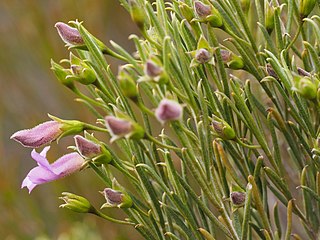
Eremophila labrosa is a flowering plant in the figwort family, Scrophulariaceae and is endemic to Western Australia. It is a shrub with many hairy branches arising from near ground level, narrow, hooked leaves and mauve and blue flowers.
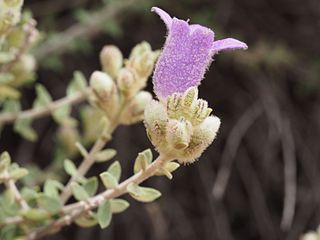
Eremophila malacoides, commonly known as frontage poverty bush, is a flowering plant in the figwort family, Scrophulariaceae and is endemic to Western Australia. It is a shrub with grey-green foliage, densely hairy leaves, and usually lilac to purple flowers but a yellow flowered form also occurs.
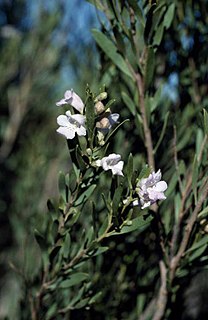
Eremophila paisleyi is a plant in the figwort family, Scrophulariaceae and is endemic to Australia. It is a rounded, broom-shaped shrub with white or lilac-coloured flowers which occurs in Western Australia, South Australia and the Northern Territory.
Eremophila petrophila is a flowering plant in the figwort family, Scrophulariaceae and is endemic to Western Australia. It is a tall, erect, open shrub with rough branches, narrow, sticky leaves and pale lilac-coloured flowers.
Eremophila phillipsii is a flowering plant in the figwort family, Scrophulariaceae and is endemic to Western Australia. It is a tall, erect, open shrub, with narrow leaves and lilac to purple flowers which are white with purple spots inside. It often has an offensive smell.

Eremophila rotundifolia is a flowering plant in the figwort family, Scrophulariaceae and is endemic to Australia. It is a shrub with many tangled branches with its leaves and branches covered with a layer of silvery-grey hairs. Its flowers range in colour from pale to deep lilac. It is common in South Australia and there is also a single record from the Northern Territory.
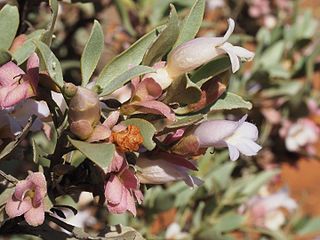
Eremophila tietkensii is a flowering plant in the figwort family, Scrophulariaceae and is endemic to Australia. It is a rounded to flat-topped shrub with grey-green leaves, usually pinkish-purple sepals and mauve, pink or lilac-coloured petals. It is mostly found in Western Australia but also occurs in the far west of the Northern Territory.
Eremophila verrucosa is a flowering plant in the figwort family, Scrophulariaceae and is endemic to South Australia. It is an erect, broom-shaped shrub with its leaves and branches covered with yellow-grey scales and lilac to purple flowers.

Eremophila willsii is a flowering plant in the figwort family, Scrophulariaceae and is endemic to Australia. It is an erect shrub with bright green, often serrated leaves and pinkish to deep pinkish-purple petals. It is mainly found in Western Australia, the Northern Territory and South Australia in deep sand.



















